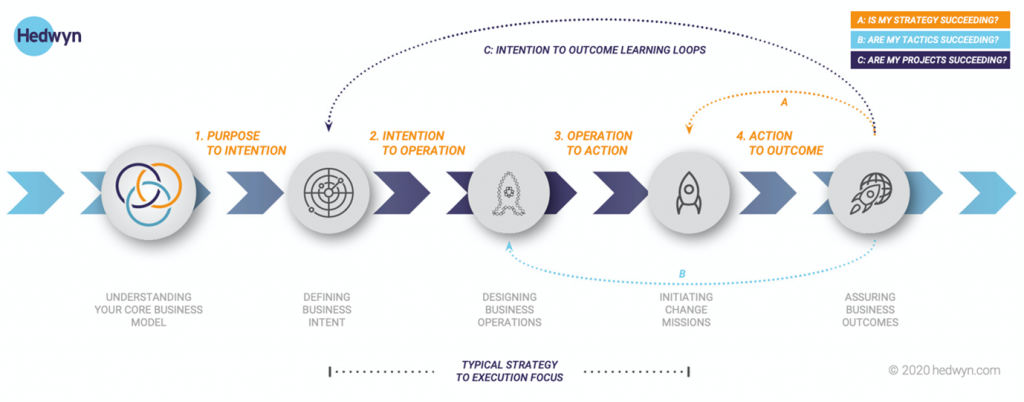The ability of your organisation to thrive is linked to how rapidly it can accommodate, adapt to, or avoid the challenges coming from the competitive environment. With the increase in economic shocks (like Brexit, Covid-19, elections, impending recessions), the corporate planning process must be more responsive, occur more frequently, and have a stronger linkage with delivered outcomes. Mere execution of predefined programmes is no longer enough — nothing stands still long enough for that! Some 98% of strategies are never successfully executed.

Philip Hellyer, Senior Consultant, Philip & Finch co-authored by By David O’Hara, Owen Muir.
Philip & David will be presenting the following course via live streaming: ‘Enterprise Architecture Fundamentals‘ 16 March 2021
Philip spoke at the Virtual IRM UK Business Change & Transformation Conference Europe co-located with the Virtual Business Process Management & Enterprise Architecture Conference Europe 27-28 October 2020 on the subject, ‘Transforming Innovation – Experiments with Experimentors‘
It might be obvious to you as analysts and architects, but when a shock affects the business environment, strategies should be reviewed and assumptions tested, along with the related operating models, projects, programmes, and roadmaps. That doesn’t always happen; business continuity plans and corporate risk strategies are generally designed to restore the status quo of a world that no longer exists.
The requirement for rapid decision making is increasing. In many organisations, even without the economic shock-factor, business strategy is essentially a snapshot; informed by what was known and believed at a point in time, often quite a while ago. By the time a change programme is implemented the world has moved on and new strategies are required.
“Life moves pretty fast. If you don’t stop and look around once in a while, you could miss it”
—Ferris Bueller, 1986 (whilst on his day off)
Traditional Strategy to execution methodologies no longer reflect the real pace needed to succeed in an ever-changing environment. Planning and feedback processes must match the speed and scale of response that your environment demands. Accordingly, companies should establish learning loops across the whole Intention to Outcome cycle.
Strategies are designed to address issues and opportunities relevant to an organisation at a specific time and drive a business towards a future vision. However, while the overall intention of a business strategy or change programme may remain constant, the strategies themselves don’t need to be.
Instead of strategy to execution as a linear process, we prefer to think in terms of Intention to Outcome, delivering change incrementally while keeping one eye on the longer-term goals, but learning as we go and adjusting our approaches mid-flight.
Intention commits us to specified business Outcomes. But strategy, the way in which we will go about realising those outcomes, should not be fixed and unchanging. Observing the effects of your actions as you go enables you to think and act more intentionally while progressively learning from what works, pushing out your planning horizon as uncertainty decreases without being locked into rigid, long-running courses of action.

In a typical Strategy to Execution methodology, information flows from left to right, with little or no opportunity for feedback until a stage-gate or post-implementation review.
A continuous, two-way flow of information gives us the ability to adjust both the programme itself and the strategy that created it, based on what we observe. There’s an inevitable degree of linearity in delivering any project, but some tensions need to be updated as events progress. Some shifts in the world will change the assumptions behind your strategies and operating models, so that your roadmaps are no longer connected to the outcomes that are now needed, whilst some tactics may simply be superseded by emerging circumstances.
The three main learning loops to inform your decisions across the Intention to Outcome cycle are:
A. Outcome back to Action – are your programmes are succeeding?
B. Outcome back to Operation – are your tactics are succeeding?
C. Outcome back to Intention – are your strategies are succeeding?
The frequency and time horizon of the loops will vary with your level of certainty and as the environment changes. Ensuring the learning loops exist enables you to continuously adapt either the scope or style of project delivery (A), reinforce or abandon certain tactics (B) or make changes to broader courses of action (C), at a greater frequency and with less disruption than having to go back through the full Strategy to Execution cycle.
An external shock that requires you to change your core business model, by definition comes from outside the intention-to-outcome cycle. But as long as your core model remains viable, having a flexible and repeatable way to pivot (ugh!) is so important right now; not only for the continuity of as-is operations but for the continuity of your business.
Of course, not everything needs to be reviewed and refreshed to the same depth or at the same frequency. It’s a question of how frequently the information feedback loops need to cycle in order to match (or exceed) the externally imposed pace of change. Sometimes slower is better, but that needs to be a deliberate and informed choice. i.e. a strategic decision based on the speed of response demanded by your situation. The frequency of planning and the timeliness of your feedback loops will change, just as your planning horizons will change with your level of certainty and the necessary reaction times.
To put it simply: you can’t wait until the next budget cycle to learn from the results of long-running programmes. Observing and adapting continuously as you are acting on your intent is what enables you to plan your next-next move. All of which requires new skills, habits, and approaches.
Philip Hellyer is an enterprise business architect specialising in whole system change. With a background in accountancy, humanities, and computing science, he works on all ‘sides’ of the strategy fence, championing approaches that improve systemic structure and reduce unintended consequences. Philip was the EA Group Lead at Carphone Warehouse and he edited Intersection, the book on Enterprise Design. Now a strategy consultant with Hedwyn, he works with organisations seeking a ‘sea change’ in their structural performance. His 2017 training course on systems thinking and storytelling was adopted as standard by a bank’s architecture group. As a coach and mentor, he accelerates the careers of smart people with deep technical skills.
Hedwyn specializes in strategic planning and business improvement. We work with people who own and lead businesses, helping them to make better decisions, respond to uncertainty, and continuously deliver value.
You can talk to us at hello@hedwyn.com
Copyright Philip Hellyer, David O’Hara, Owen Muir


